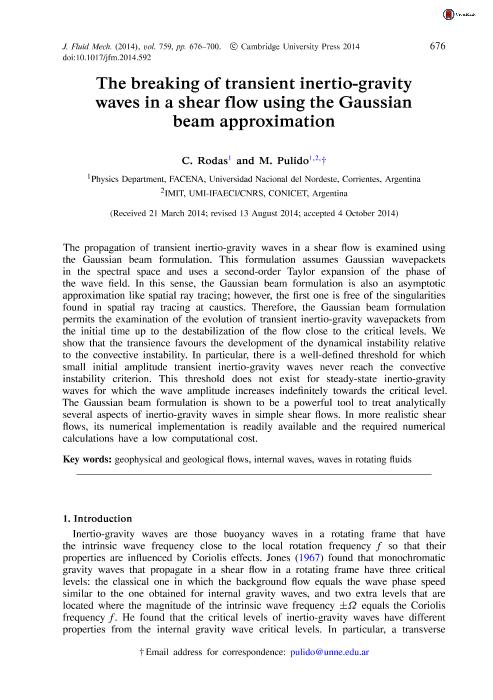Artículo
The breaking of transience inertio-gravity waves in a shear flow using the Gaussian beam approximation.
Fecha de publicación:
11/2014
Editorial:
Cambridge University Press
Revista:
Journal of Fluid Mechanics
ISSN:
0022-1120
Idioma:
Inglés
Tipo de recurso:
Artículo publicado
Clasificación temática:
Resumen
The propagation of transient inertio-gravity waves in a shear flow is examined using the Gaussian beam formulation. This formulation assumes Gaussian wavepackets in the spectral space and uses a second-order Taylor expansion of the phase of the wave field. In this sense, the Gaussian beam formulation is also an asymptotic approximation like spatial ray tracing; however, the first one is free of the singularities found in spatial ray tracing at caustics. Therefore, the Gaussian beam formulation permits the examination of the evolution of transient inertio-gravity wavepackets from the initial time up to the destabilization of the flow close to the critical levels. We show that the transience favours the development of the dynamical instability relative to the convective instability. In particular, there is a well-defined threshold for which small initial amplitude transient inertio-gravity waves never reach the convective instability criterion. This threshold does not exist for steady-state inertio-gravity waves for which the wave amplitude increases indefinitely towards the critical level. The Gaussian beam formulation is shown to be a powerful tool to treat analytically several aspects of inertio-gravity waves in simple shear flows. In more realistic shear flows, its numerical implementation is readily available and the required numerical calculations have a low computational cost.
Archivos asociados
Licencia
Identificadores
Colecciones
Articulos(IMIT)
Articulos de INST.DE MODELADO E INNOVACION TECNOLOGICA
Articulos de INST.DE MODELADO E INNOVACION TECNOLOGICA
Citación
Rodas, Claudio José Francisco; Pulido, Manuel Arturo; The breaking of transience inertio-gravity waves in a shear flow using the Gaussian beam approximation.; Cambridge University Press; Journal of Fluid Mechanics; 759; 11-2014; 676-700
Compartir
Altmétricas




